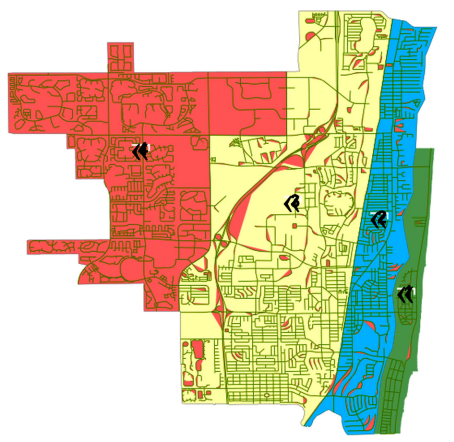BOCA RATON — Boca Raton has identified the first string of decades-old beachside buildings that will face newly required inspections after last year’s deadly Surfside condo collapse raised statewide concerns about older structures.
|
The city of Boca Raton has identified 191 properties, some of which include multiple buildings, that need inspections for structural safety, according to Brandon Schaad, director of development services for the city. The city has been divided into four zones to prioritize buildings by age and proximity to the ocean. The soonest deadline for inspection is Feb. 1, 2023. |
Records show the
building had significant structural damage in its
underground parking garage. An engineer had already
concluded that $15 million of repairs would be required to
bring it up to code. Some of the damage at the oceanside
building is believed to have come from saltwater in the air.
In August, two months after the Surfside collapse, Boca
Raton passed a new law requiring inspections for most condo
buildings over 30 years old in city limits.
It was among the first cities in Florida to pass such a
measure while Palm Beach County deferred to the state
Legislature to take action, but no such law was enacted
statewide.
Palm Beach County remains in a wait-and-see mode regarding
enhanced building inspections. In October, the County
Commission held off on taking any new measures until after
the State Legislature met in January in hopes they would
institute new statewide regulations.
“The best thing would be for the state to take the lead on
this,” Commissioner Gregg Weiss said in October, while
noting if the state didn’t take action the county was “going
to have to do something to make sure things are being done
properly.”
While the Legislature did not take any action at the time,
the state is reconvening for a special legislative session
next week.
As a result, Palm Beach County will wait until after the
session before taking any action on enhanced building
inspections and will likely revisit the topic later this
summer, Assistant County Administrator Patrick Rutter said.
Looking ahead
Last week, Boca Raton city officials approved the fees for
building owners. Affected property owners will need to pay a
$500 fee to have their buildings inspected and submit a
required report to the city’s building department.
The buildings have been prioritized largely from east to
west because experts say buildings closest to the ocean are
at highest risk of the impact of saltwater on concrete,
steel and other building materials.
Within each zone the city established, older buildings are
given the earliest deadlines. In addition to Zone 1, Zone 2
covers the Intracoastal Waterway, west to Dixie Highway;
Zone 3 spans Dixie Highway to west of I-95; and Zone 4 goes
west of I-95.
The city expects inspections for all the buildings they’ve
identified to take about four years.
The latest deadlines for inspections — essentially, the
oldest ones farthest from the beach — aren’t until Nov. 1,
2026.
As part of the city’s program, it has already hired a
building recertification inspector and must still hire an
administrative assistant, according to Olmsted. The city has
also started seeking an engineering team to contract with.
The city has previously estimated the cost of the program at
around $250,000 per year, plus salaries of the inspector and
assistant. Those costs will be funded, at least in part, by
the $500 fees from property owners.
The South Florida Sun Sentinel attempted to reach owners and
management for the initial 14 properties, but none responded
to requests for comment.
